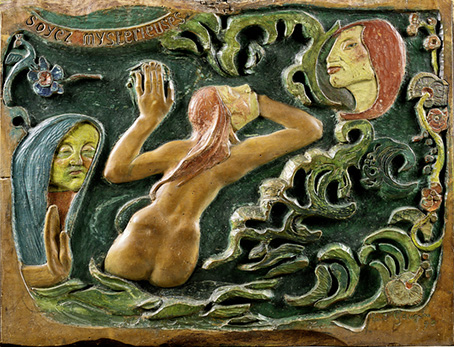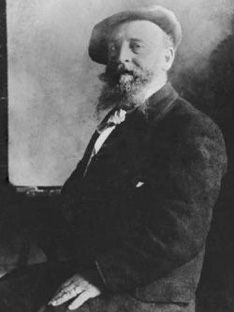
Home |
||
|---|---|---|
Before the exhibitions |
Eight Impressionism exhibitions |
After the exhibitions |
|
||
Summary and outlook
Summary after the 1886 exhibition
Following the disputes, some of the painters did not take part in the eighth exhibition: Caillebotte, Cézanne, Monet, Renoir and Sisley. They tried to find accommodation elsewhere, for example with the gallery owner Georges Petit, a competitor of Paul Durand-Ruel. Renoir had contributed several paintings to an exhibition of the Belgian group "Les Vingt", as had Claude Monet. Some of the painters were disappointed by their long-time patron Durand-Ruel, as they had the impression that nothing more could be sold through him.
Durand-Ruel himself only returned from America after the eighth exhibition and was able to report that he had been successful, but that the costs had been very high. This was double-edged news for the painters, but with a view to the future it must be said that Impressionism had now gained a foothold in America thanks to Durand-Ruel's efforts and was very successful. Certainly also thanks to the constant advertising by the American Mary Cassatt.Cézanne also slowly came to rest in 1886. With his parents' consent, he finally married Hortense Fiquet. When his father died six months later, he left Cézanne a considerable fortune, which relieved him of all his worries. However, he retired alone to the country house "Jas de Bouffan" (his wife and son lived alternately in Marseille or Paris). Of his old friends, only Pissarro, Renoir, Chocquet and Père Tanguy remained, but Cézanne no longer had much contact with them either. He also took part in an exhibition of Les Vingt in Brussels in 1890.
In addition to Durand-Ruel and his fiercest competitor Georges Petit, other gallery owners now took on the task of bringing Impressionist painting to the world: Ambroise Vollard, Boussod & Vallodon and Goupil & Cie (with Theo van Gogh) now also contributed to its dissemination. Another opportunity for the artists was to take part in the Les Vingt exhibition in Brussels.
Examples of the participation of some of the painters in the eight exhibitions in events organised by the "Les Vingt" group in Brussels
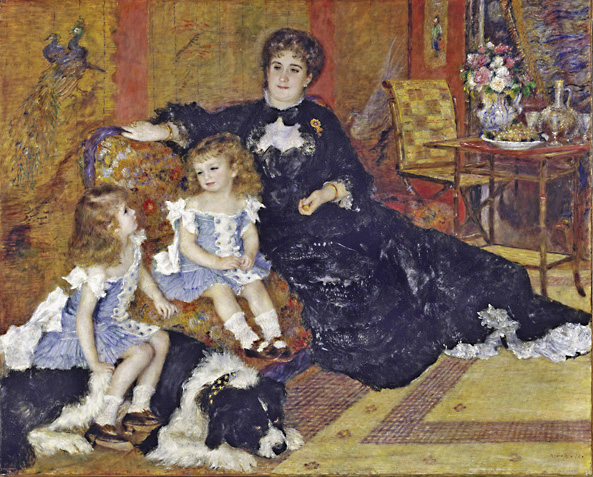
Auguste Renoir - Madame Georges Charpentier et ses enfants
1878 - 154 x 190 cm - Oil on canvas
The Metropolitan Museum of Art, New York, USA >
"IIIe exposition annuelle des XX, Brüssel, 1886"
.jpg)
Claude Monet - Le Manneporte (Étretat)
1883 - 65 x 81 cm - Oil on canvas
The Metropolitan Museum of Art, New York, USA >
"IIIe exposition annuelle des XX, Brüssel, 1886"
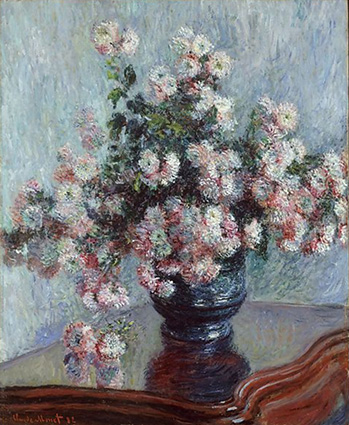
Claude Monet - Chrysanthèmes
1882 - 100 x 81 cm - Oil on canvas
The Metropolitan Museum of Art, New York, USA >
"IIIe exposition annuelle des XX, Brüssel, 1886"
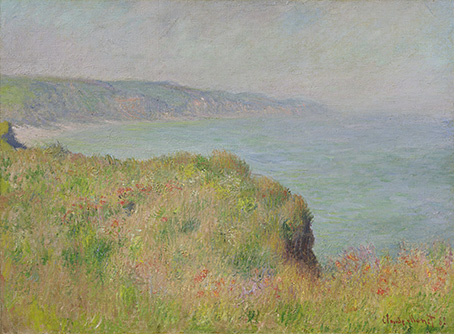
Claude Monet - Falaise à Pourville
1882 - 60 x 81 cm - Oil on canvas
Museum Barberini, Potsdam, Germany >
"IIIe exposition annuelle des XX, Brüssel, 1886"
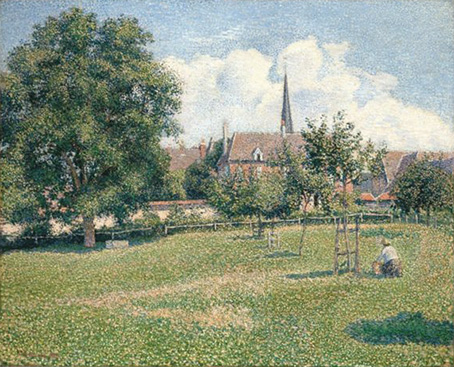
Camille Pissarro - La Maison de la Sourde et Le Clocher d'Eragny
1886 - 65 x 81 cm - Oil on canvas
Indianapolis Museum of Art at Newfields, Indianapolis, USA >
"IVe exposition annuelle des XX, 1887"
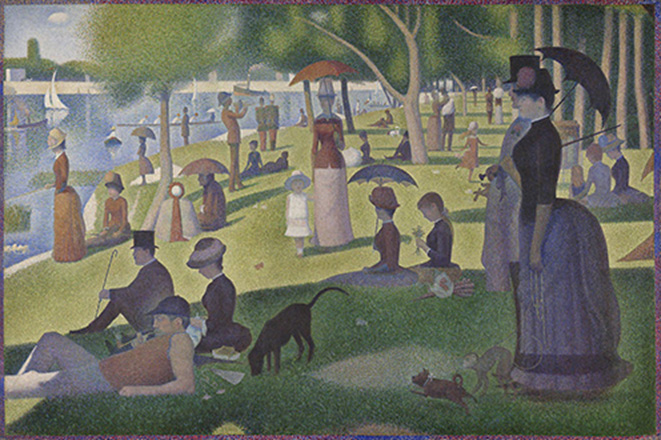
Georges Seurat - Un dimanche à la Grande-Jatte
1884/86 - 207 x 308 cm - Oil on canvas
Art Institute of Chicago, USA >
"IVe exposition annuelle des XX, 1887"
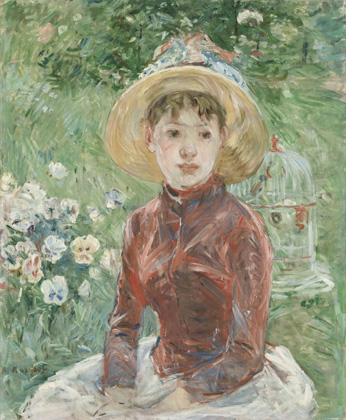
Berthe Morisot - Jeune fille sur l'herbe.
1885 - 73 x 60 cm - Oil on canvas
Ordrupgaard Collection, Kopenhagen, Denmark >
"IVe exposition annuelle des XX, 1887"
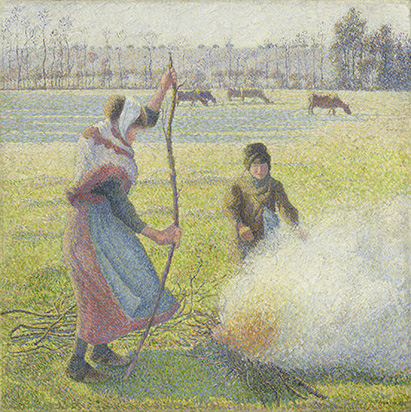
Camille Pissarro - Gelée blanche, Jeune Paysanne faisant du feu
1888 - 93 x 92 cm - Oil on canvas
Museum Barberini, Potsdam, Germany >
"VIe exposition annuelle des XX, 1889"
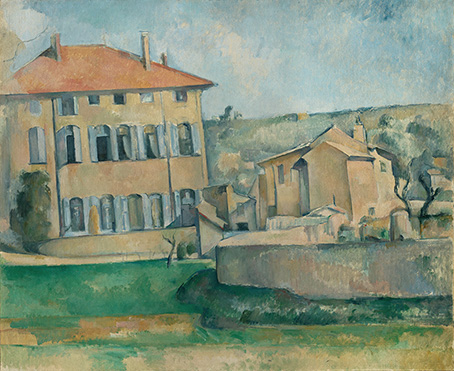
Paul Cézanne - Jas de Bouffa
1885/87 - 61 x 74 cm - Oil on canvas
National Gallery Prague, Czech Republic >
"VIIe exposition annuelle des XX, 1890"
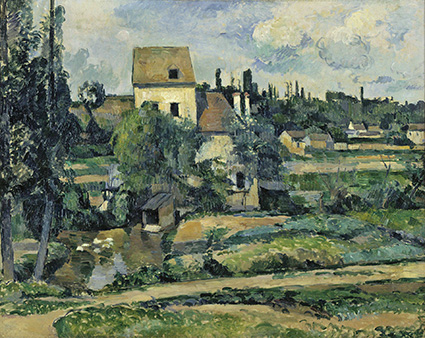
Paul Cézanne: Moulin sur la Couleuvre près de Pontoise
1880 - 73 x 91 cm - Oil on canvas
Staatliche Museen zu Berlin, Germany >
"VIIe exposition annuelle des XX, Brüssel, 1890"
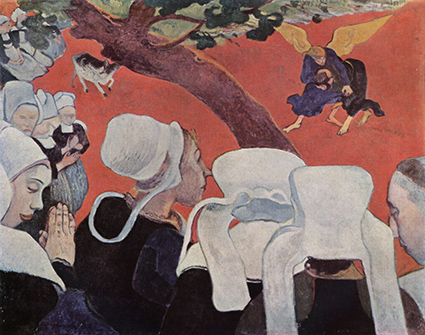
Paul Gauguin - Vision après le sermon (Jacob luttant avec l'ange)
1888 - 72 x 91 cm - Oil on canvas
Scottish National Gallery, Edinburgh, Scotland
"VIe exposition annuelle des XX, 1889"
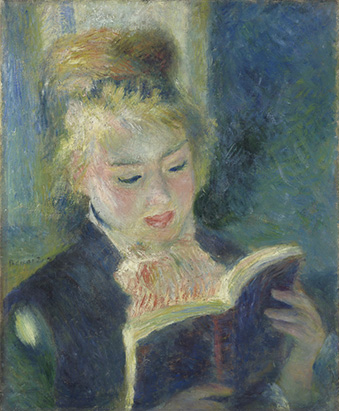
Auguste Renoir - La Liseuse
1874/76 - 46,5 x 38, 5 - Oil on canvas
Musée d'Orsay, Paris, France >
"VIIIe exposition annuelle des XX, 1891"
Paul Gauguin - Soyez mystérieuses
1890 - 73 x 95 x 5 cm - Painted lime wood bas-relief, coloured pencil
Musées d'Orsay, Paris, France >
"VIIIe exposition annuelle des XX, 1891"
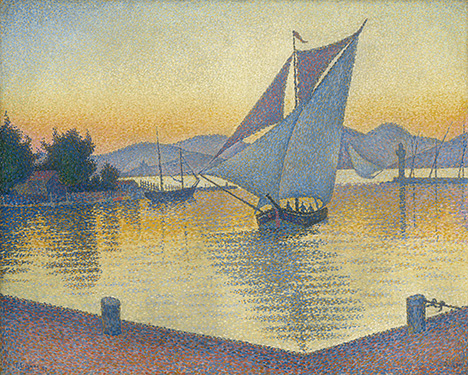
Paul Signac - Le port au coucher du soleil
1892 - 65 x 81 cm - Oil on canvas
Museum Barberini, Potsdam, Germany >
"Xe exposition annuelle des XX, 1893"
An attempt at a ninth exhibition is no longer made. The artists had grown too far apart and were at odds with each other. Vincent van Gogh, who met some of the painters at this time, summarised the situation as follows when, in a letter to Émile Bernard in 1888, he spoke of "disastrous quarrels", "jumping down each other's throats with a fervour worthy of a nobler and better purpose." Despite this statement, he would always admire the Impressionist group and later wrote to Bernard, even though all common ground had been lost among the Impressionists: "More and more it seems to me that the paintings that are supposed to validly represent contemporary painting as such are beyond the power of an individual; they must therefore probably be created by groups that unite to realise a common idea."
Examples of painters who had not contributed to the eighth exhibition
and who went their own way from then on:
Gustave Caillebotte
1848 - 1894
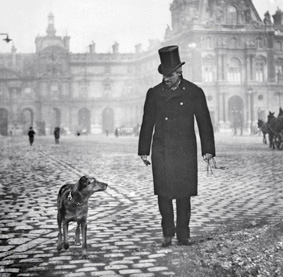
As early as 1880, Caillebotte partially retired to his country estate in Petit Gennevilliers. He became a boat builder and founded his own company. When Caillebotte died of a stroke in 1894 at the age of just forty-five, he was a recognised, albeit not uncontroversial, painter. In addition to his own works, he left behind a large collection of Impressionist paintings, which were bequeathed to the French state, which only accepted half of them.
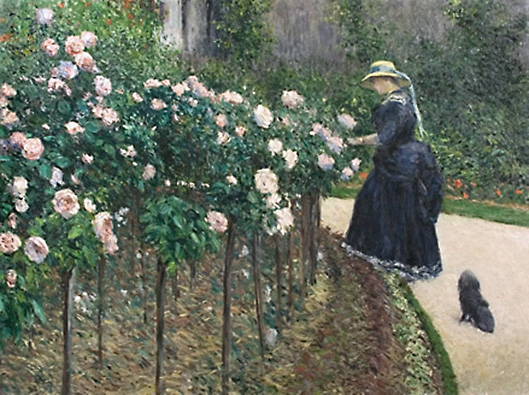
Les roses, jardin du Petit Gennevilliers
1886 - 89 x 116 cm - Oil on canvas
Private collection
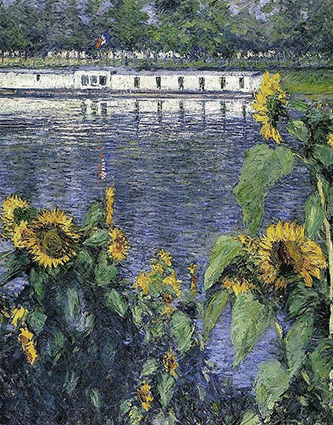
Tournesols en bord de Seine
1885 - 90 x 71 cm - Oil on canvas
Private collection
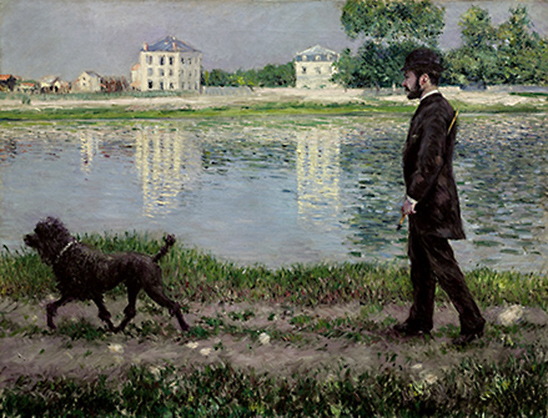
Richard Gallo et son Chien Dick, au Petit-Gennevilliers
1884 - 89 x 116 cm - Oil on canvas
Private collection
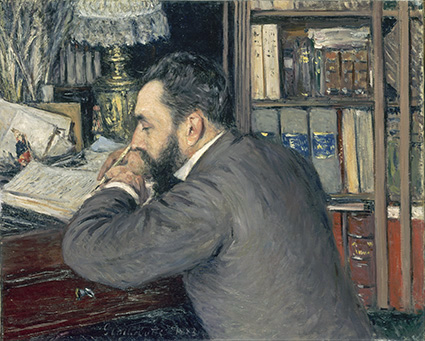
Henry Cordier
1883 - 65 x 82 cm - Oil on canvas
Musée d'Orsay, Paris, France
>
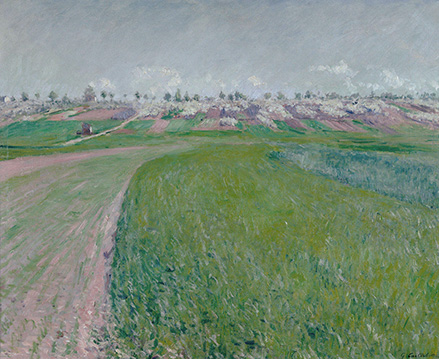
Colline à Colombes
1884 - 60 x 73 cm - Oil on canvas
Wallraf-Richardz-Museum, Cologne, Germany >
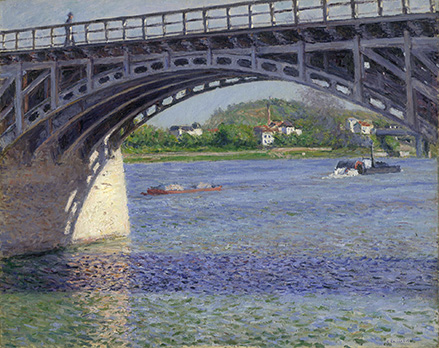
Le pont d'Argenteuil et la Seine
ca. 1883 - 65 x 82 cm - Oil on canvas
Museum Barberini, Potsdam, Germany >
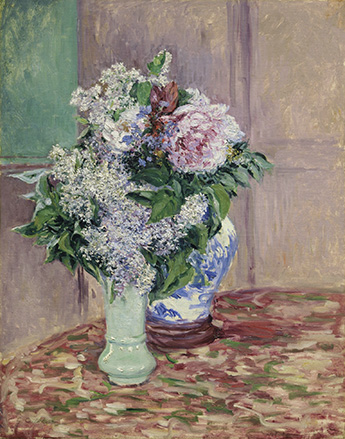
Lilas et Pivoines dans deux vases
1887 - 92 x 72 cm - Oil on canvas
Museum Barberini, Potsdam, Germany >
»»»«««
Paul Cézanne
1839 - 1906
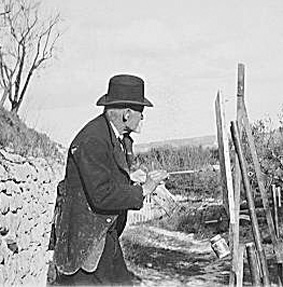
After his father's death, he was rid of his money worries. "My father was a brilliant man," he said looking back, "he left me an income of 25,000 francs." He exhibited at group exhibitions of "Le Vingt" in Belgium in 1890 and in November 1895 he was able to present his first solo exhibition with 50 works at Ambroise Vollard in Paris. The prices for his paintings now rose rapidly. Museums were now also buying works. His painting style became more compact, pictures were created from colour rather than drawing. He played with geometric shapes and reduced the subject matter. The proportions became more unrealistic. It is all about the interplay of shapes and colours. A kind of abstraction, the contemplation of which would later lead to the cubism of Picasso and others.
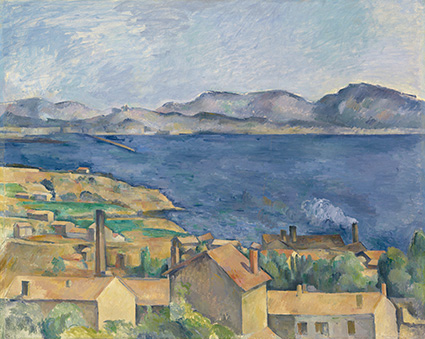
Baie de Marseille
ca. 1890 - 80 x 101 cm - Oil on canvas
Art Institute of Chicago, USA >
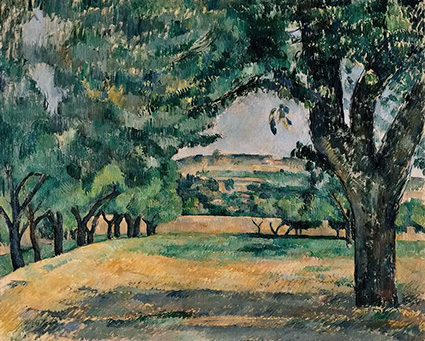
Environs du Jas de Bouffan
1885/87 - 65 x 81 cm - Oil on canvas
Guggeneheim Foundation, New York, USA >
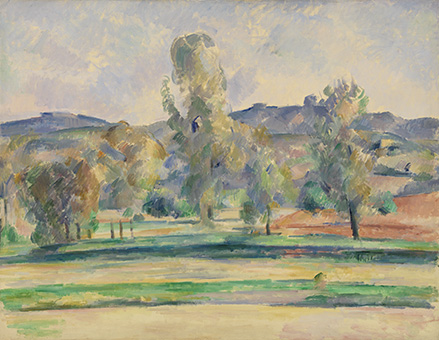
Paysage d'automne
1883/85 - 62 x 80 cm - Oil on canvas
Barnes Collection, Philadelphia, USA >
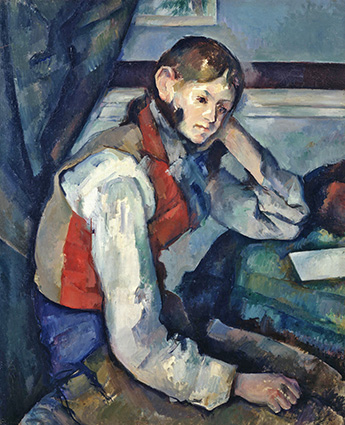
Garçon avec le gilet rouge
1888/90 - 79 x 64 cm - Oil on canvas
Sammlung E. G. Bührle, Zürich, Suisse >
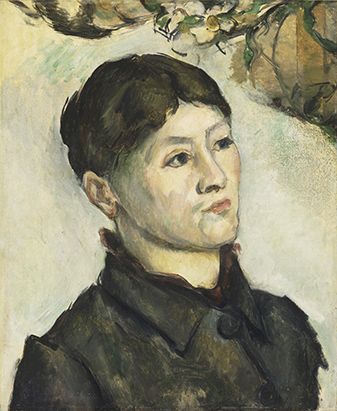
Portrait Madame Cézanne
1883/85 - 46 x 38 cm - Oil on canvas
Philadelphia Museum of Art, Philadelpia, USA >
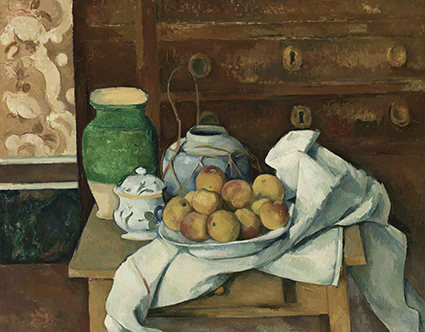
Nature morte avec commode
ca. 1883/87 - 73 x 97 cm - Oil on canvas
Neue Pinakothek, München, Germany >
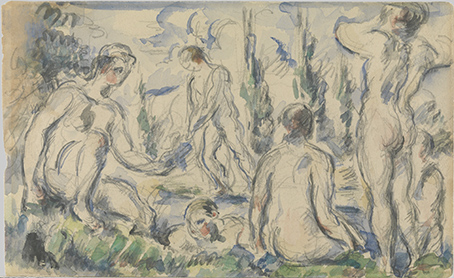
Baigneuse
ca. 1888 - 12,6 x 20,6 cm - Watercolour and graphite on paper
The Metropolitan Museum of Art, New York, USA >
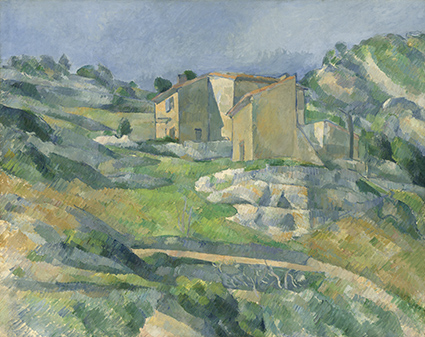
Maisons en Provence: La vallée de Riaux près de l'Estaque
ca. 1883 -
65 x 81 cm - Oil on canvas
National Gallery of Art, Washington, USA >
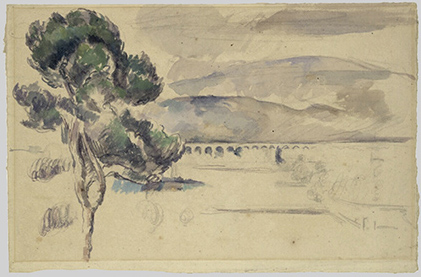
La vallée de l'Arc avec le viaduc et le pin
ca. 1883/85 - 31,4 x 48,5 cm - Watercolour over pencil sketch
Grafiksammlung Albertina, Vienna, Austria >
»»»«««
Claude Monet
1840 - 1926
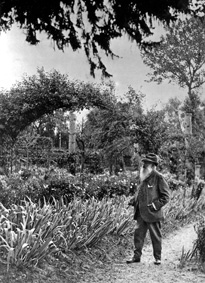
Claude Monet spent the years after 1886 mostly in Brittany, then in the south of France. He bought the house in Giverny in 1890, having lived there on and off for seven years. The regular sales of his paintings made him more independent and so he invested a lot of money in extending his house, including his studio and the now famous garden. In 1891, Monet legalised his relationship with Alice Hoschedé. Monet then travelled extensively and built another large studio in Giverny for his water lily paintings. He retained his Impressionist style until the end of his life. Monet painted nature as he experienced it, not an exact reality. He tried to capture moods, the impression that nature made on him.
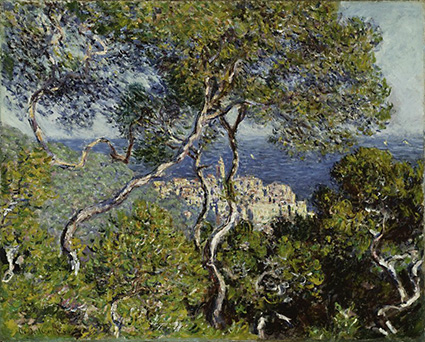
Bordighera
1884 - 65 x 80 cm - Oil on canvas
Art Institute Chicago, USA >
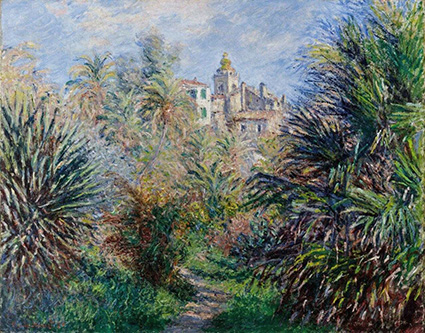
Villa Moreno, Bordighera
1884 - 73 x 93 cm - Oil on canvas
Norton Museum of Art, Palm Beach, USA >
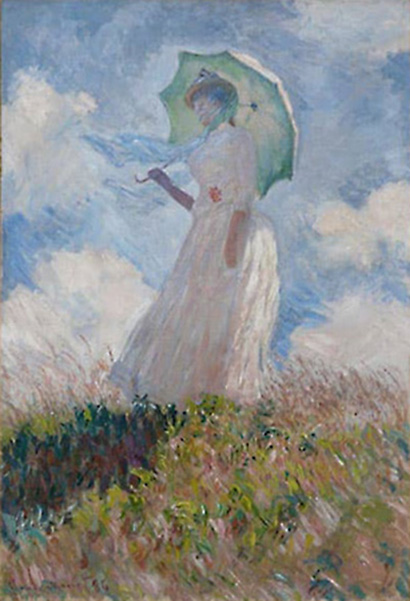
Femme à l'ombrelle
1886 - 131 x 88 cm - Oil on canvas
Musée d'Orsay, Paris, France >
Monet had already painted this motif 10 years earlier with Camille Monet.
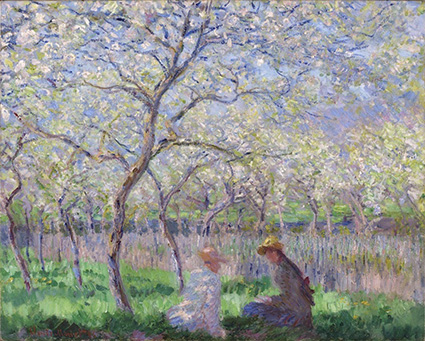
Printemps
1886 - 65 x 81 cm - Oil on canvas
The Fitzwilliam Museum, Cambridge, United Kingdom >
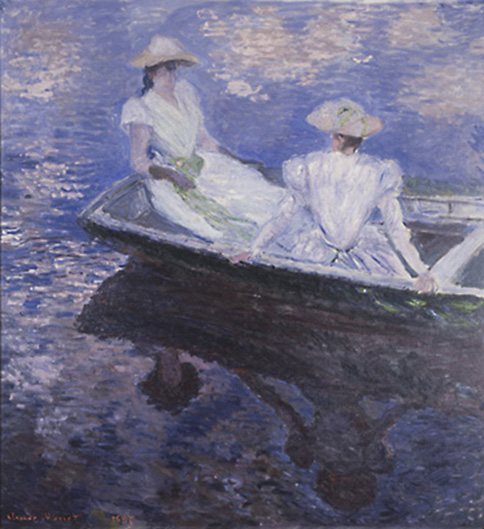
Sur le bateau
1887 - 145 x 133 cm - Oil on canvas
National Museum of Western Art, Tokio, Japan
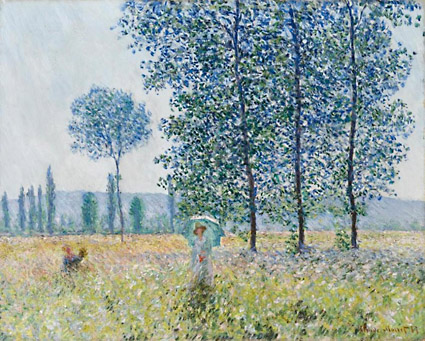
Effet de la lumière du soleil sous les peupliers
1887 - 74 x 93 cm - Oil on canvas
Staatsgalerie Stuttgart, Germany >
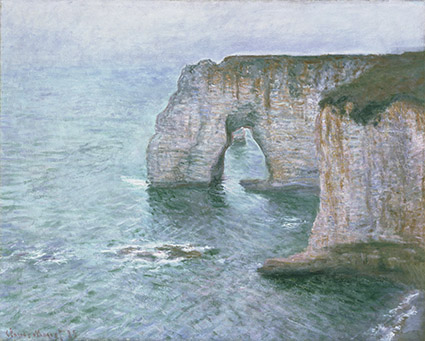
Manne Porte, Étretat
1885 - 65 x 81 cm - Oil on canvas
Philadelphia Museum of Art, Philadelphia, USA >
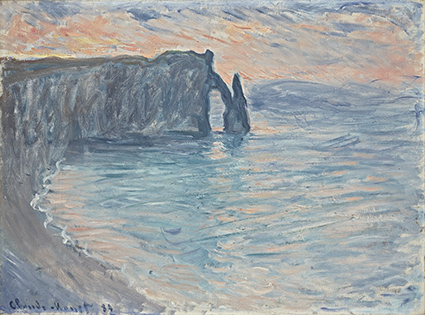
Manne Porte, Étretat
1884 - 60 x 81 cm - Oil on canvas
Kunstmuseum Basel, Suisse >
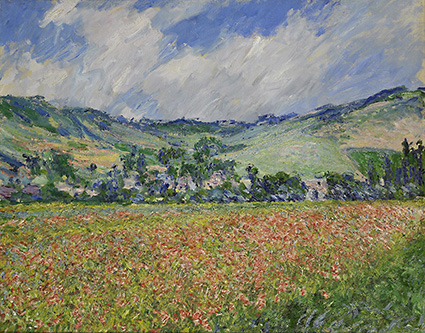
Champ de Coquelicots, Environs de Giverny
1885 - 66 x 81 cm - Oil on canvas
Musée des Beaux-Arts de Rouen, France >
»»»«««
Auguste Renoir
1841 - 1919
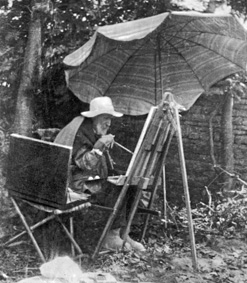
Auguste Renoir had not yet ended his creative crisis (as he himself saw it) at the time of the eighth exhibition. His artistic interest was now focussed on form and contour painting. This period is known as the "dry period". Renoir saw himself more as a craftsman at this time. After a stay with Paul Cézanne in Aix-en-Provence, Renoir broke away from the strict forms again and returned to his own free style. He now lived on the Côte d'Azur. Chronic arthritis increasingly hindered him in his work, but he continued to paint until the end of his life.
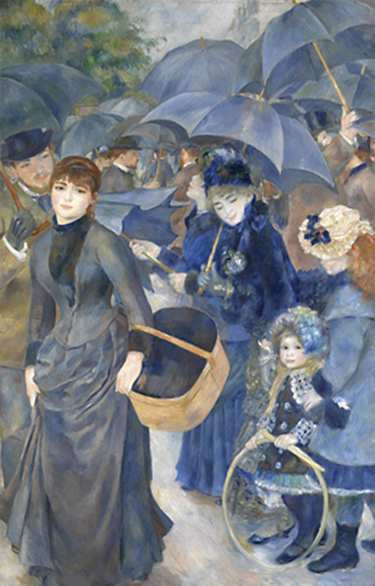
Les parapluies
1880/86 - 180 x 115 cm - Oil on canvas
Hugh Lane Gallery, Dublin, Ireland >
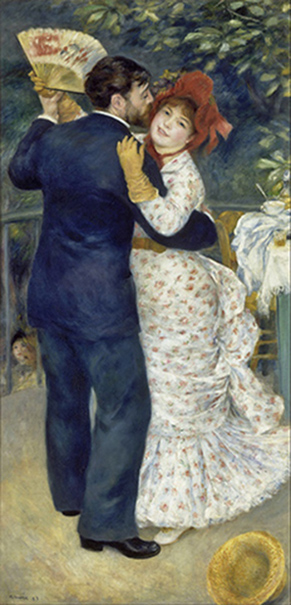
Danse à la campagne
1883 - 180 x 90 cm - Oil on canvas
Musée d'Orsay, Paris, France >
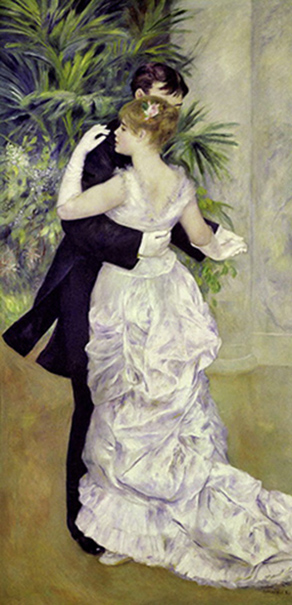
Danse à la ville
1883 - 180 x 90 cm - Oil on canvas
Musée d'Orsay, Paris, France >
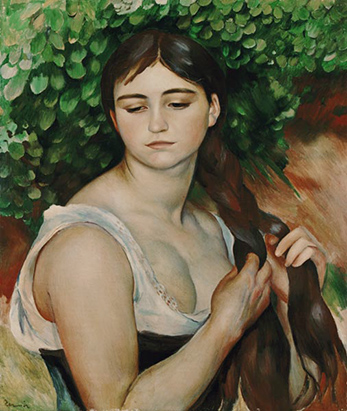
Der Zopf
ca. 1886/87 - 57 x 47 cm - Oil on canvas
Museum Langmatt, Baden, Schweiz >
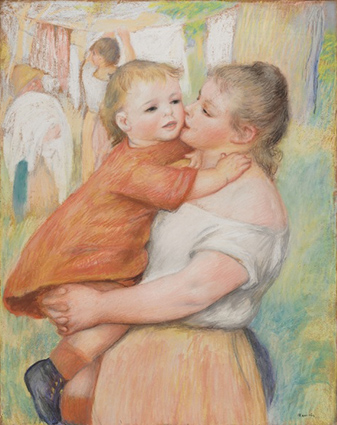
Aline et Pierre
1886 - 79 x 64 cm - Pastel
The Cleveland Museum of Art, Cleveland, USA >
Au jardin
1885 - 170 x 112 cm - Oil on canvas
Hermitage Museum, St. Petersburg, Russia
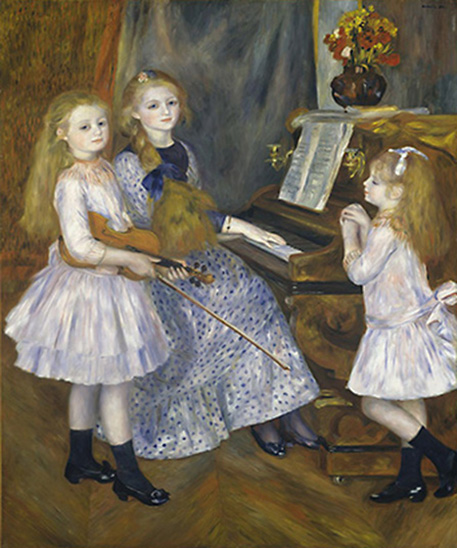
Les filles de Catulle Mendes
1888 - 162 x 130 cm - Oil on canvas
The Metropolitan Museum of Art, New York, USA >
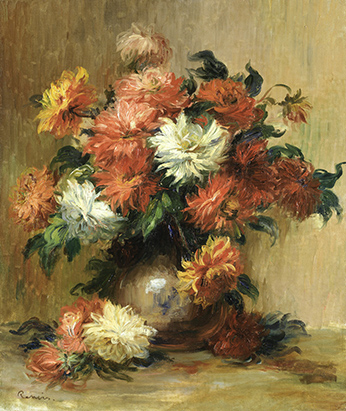
Dahlien
1885/90 - 65 x 54 cm - Oil on canvas
Sammlung Emil Bührle, Zürich, Suisse >
»»»«««
Alfred Sisley
1839 - 1899
Alfred Sisley was not very successful during his lifetime, but he was very consistent in maintaining his Impressionist style. His lack of success was also linked to a difficult financial situation, which drove him into poverty. It was only after his death that the public became aware of the extraordinary harmony of colour and pictorial power in his art of painting.
Throat cancer, from which he suffered from 1895 onwards, finally led to his death in 1899.
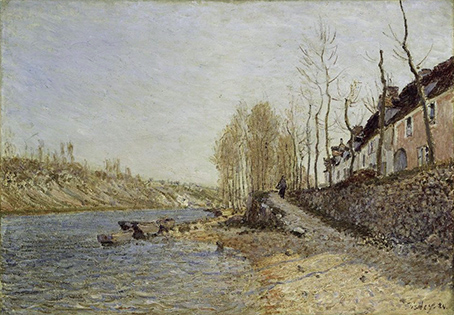
La Croix-Blanche at Saint-Mammès
1884 - 65 x 92 cm - Oil on canvas
Museum of Fine Arts, Boston, USA >
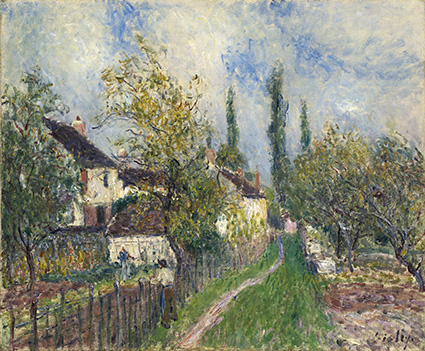
Un sentier aux Sablons
1883 - 46 x 55 cm - Oil on canvas
National Gallery of Australia, Canberra, Australia >
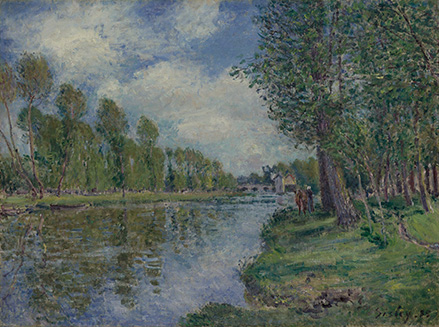
Rives de la rivière Loing
1885 - 55 x 73 cm - Oil on canvas
Philadelphia Museum of Art, Philadelphia, USA >
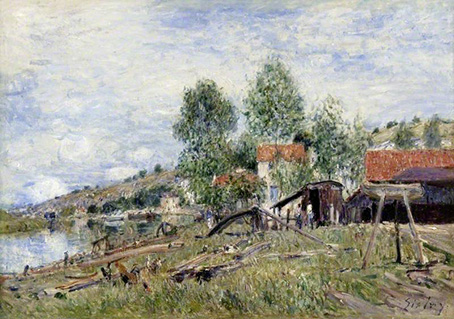
Chantier à Saint Mammes
ca. 1886 - 39 x 56 cm - Oil on canvas
Kelvingrove Art Gallery and Museum, Glasgow, Scotland
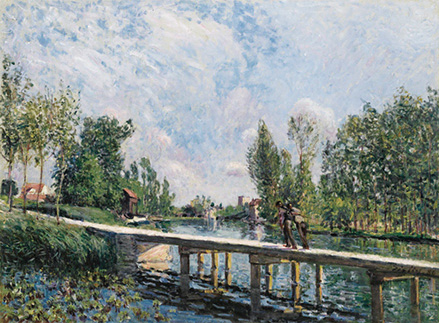
La Passerelle - Chemin de halage du canal de Loing
1886 - 49 x 65 cm - Oil on canvas
Private collection
»»»«««
Impressionism, which made a decisive contribution to the liberation of art from the tyranny of a misunderstood tradition, is today one of the great artistic traditions. Like all traditions, it will at times be rejected and then rediscovered; at times it will no longer be relied upon, at other times its vitality will be recognised. It will be both admired and opposed, but never overlooked. Impressionism is and remains one of the most important phases in the history of modern art. (John Rewald)
![]()
